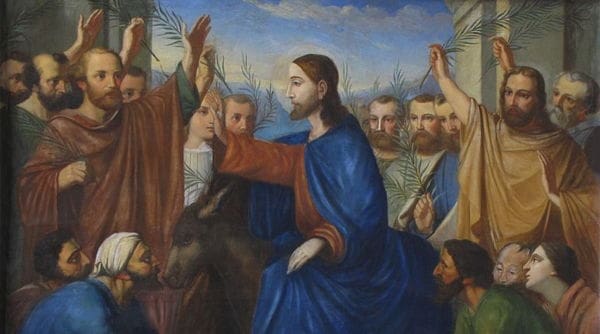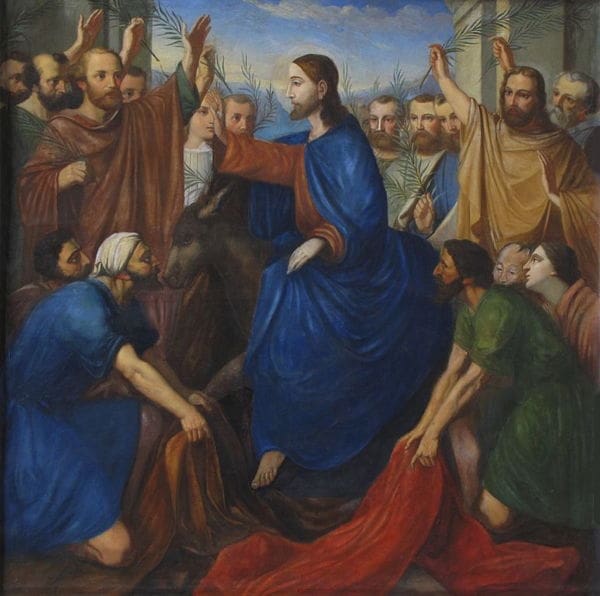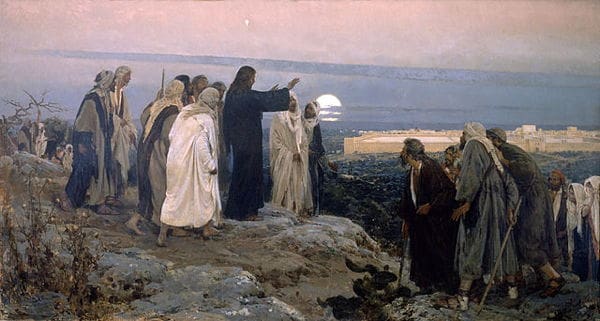Passion Sunday
Today we begin the celebration of Holy Week. We will journey spiritually with Jesus and walk along with Him from His entry into Jerusalem through the mystery of His Passion and Death and, ultimately, to His glorious Resurrection. If we die with Him we shall also live with Him (cf Romans 6:8).
 The blessed sacramental palms we receive help focus our attention on this journey. Besides also being referred to as Palm Sunday, it has sometimes been called Fig Sunday because figs were eaten as a remembrance of the fig tree cursed by Jesus after entering Jerusalem (Mark 11:12-14). At times different types of branches were used since it was difficult to get palms in areas where they were hard to grow. So, it has also had the name of Yew Sunday or Branch Sunday.
The blessed sacramental palms we receive help focus our attention on this journey. Besides also being referred to as Palm Sunday, it has sometimes been called Fig Sunday because figs were eaten as a remembrance of the fig tree cursed by Jesus after entering Jerusalem (Mark 11:12-14). At times different types of branches were used since it was difficult to get palms in areas where they were hard to grow. So, it has also had the name of Yew Sunday or Branch Sunday.
The palm, or phoenix (also phoinix) as it is known in Greek, was a symbol of highest honor, of rejoicing and triumph. It was customary to lay palms and cloaks in front of someone as an indication of submission to them. Imagine the outrage of the officials when they saw Jesus’ entry.
They all knew the symbolism of the palm contained in many places of the Old Testament. They knew the prophecy, which said “… your king shall come to you; a just savior… meek, and riding on an ass, on a colt, the foal of an ass…he will banish the chariot…and the horse…the warrior’s bow…” (cf Zechariah 9:9-10). When the Pharisees told Him to rebuke His disciples, the Lord said that the stones would cry out if they were silenced. In the minds of the Sanhedrin, then, Christ was declaring himself King.
One might ask whether it is possible to be triumphant and victorious and at the same time humble. By choosing to enter Jerusalem in the manner in which he did, Jesus showed the people the type of king he truly is. He comes in triumph but not triumphantly. He has taught as a shepherd, not as a general. Those who have heard him speak or witnessed a miracle that he worked have now been called to give witness to their experiences. They do so by proclaiming Jesus the “Son of David,” praising God the Father for sending their long awaited savior.[1]
Although He eagerly desired to drink the cup He was about to drink, Christ wept for Jerusalem as He drew near (cf Luke 19:21), for the suffering that he knew would come to them.
They knew not what they were doing. If they had known, they never would have crucified the Lord of glory (cf 1 Corinthians 2:8).
Let us then, enter into His merciful Passion:
…by how much the more we announce the Passion of the Lord, by so much the more we approach to the celebration of His Resurrection. There are yet six days till we reach the joy of that festival … Even in these six days … try to recover your ground, if ye have in any respect failed in … preceding weeks … The nearer we approach our Paschal joy, so much the purer we ought to make ourselves by fasting, by praying, by watching, and by all the works of mercy; and furthermore, to wash out our sins by continual weeping. And if any one thinks that he need not weep for his own sins, at least he ought in these days to sorrow for the sufferings of his Lord. For though He were God before all worlds, coming in the form of a servant, and being spit upon and scourged by wicked men, for their and our salvation, He did not abhor at this time to lay down His life. Let each one of you, my brethren, suffer with Him, carrying His reproach, and lamenting the blindness of those from whom He endured it. He Himself hath said in the Gospel, Blessed are they that mourn, for they shall be comforted. Grief, for a little while, is now in season, to the end that we may more freely rejoice in the holy Resurrection. The Psalmist also saith, What shall I render to the Lord for all the benefits He hath done unto Me? I will receive the cup of salvation, and call upon the Name of the Lord. By the cup we may understand both open persecution and hidden sorrow, which in some way or other must be tasted by every Christian. Let us prepare ourselves, therefore, beloved, for the coming festival, to which the Lord grant us to attain in a worthy manner. Let us, then, rejoice, not in delicacy of good living, but by sending before us the works of justice and equity…[2]
…and by the works of mercy as well! May the palms we take home today be a symbol of our communion with our Blessed Lord and His Passion…and a spur to drawing closer to Him, too.
Blessed Passion Sunday and Holy Week to one and all!
[1] Reinert, J. M. (2011). Preaching the Social Doctrine of the Church in the Mass (Vol. 3, pp. 56–58). Vatican City: Libreria Editrice Vaticana.
[2] Neale, J. M. (1856). Mediæval Preachers and Mediæval Preaching: A Series of Extracts, Translated from the Sermons of the Middle Ages, Chronologically Arranged: With Notes and an Introduction (pp. 45–47). London: J. & C. Mozley;J. Masters & Co.
+
Art for this post on Passion Sunday: “Vie de Jésus”: Entrée à Jérusalem (Life of Jesus: Entry into Jerusalem), Joseph Maximilian Seelenmayer (?-1854), 19th century, PD-US author’s life plus 70 years or less; The Palm Leaf, William-Adolphe Bouguereau, 1894, PD-US author’s life plus 100 years or less; Flevit super illam (Latín) – Lloró por ella (He wept over it), Enrique Simonet, 1892, PD-US author’s life plus 80 years or less; all Wikimedia Commons.






